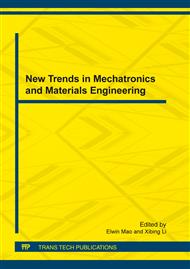[1]
K. Bhattacharyya and M. J. Deen, Microwave CMOS traveling wave amplifiers: Performance and temperature effects, IEEE Microw. Wire-less Compon. Lett. vol. 14, no. 1, p.16–18, Jan. (2004).
DOI: 10.1109/lmwc.2003.821498
Google Scholar
[2]
Y. -J. Ding, High-Power Tunable Terahertz Sources Based on Parametric Processes and Applications, IEEE Journal, vol. 13, no. 8, pp.705-720, May (2007).
DOI: 10.1109/jstqe.2007.895279
Google Scholar
[3]
M. -Y. Frankel, R. -H. Voelker, J. -N. Hilfiker. Coplanar Transmission Lines on Thin Substrates for High-speed Low-Loss Propagation, [J].IEEE Trans. On Microwave Theory and Tech., vol. 42, No. 3, (1994).
DOI: 10.1109/22.277432
Google Scholar
[4]
Ponchak George E , Alexandros Margomenos , Linda P. B. K at ehi . Low-Loss CPW on Low-Resistivity Si Substrates with a Micromachined Polyimide Interface Layer for RFIC Int ercon-nect s [ J ] . IEEE Transactions on Microwave Theo ry and Techniques , 2001 , 49 (5) : 8662870.
DOI: 10.1109/22.920142
Google Scholar
[5]
G. Wang, R. -S. Chen, W. -C. Tang, Analysis and implementation of MEMS coplanar waveguide on silicon substrate, Microwave and Millimeter Wave Technology (ICMMT), 2010 International Conference, pp.2071-2074, 8-11 May (2010).
DOI: 10.1109/icmmt.2010.5525216
Google Scholar
[6]
Youngwoo Kwon, Hong-Teuk Kim, Jae-Hyoung Park and Yong-Kweon Kim, Low-loss micromachined inverted overlay CPW lines with wide impedance ranges and inherent airbridge connection capability, Microwave and Wireless Components Letters, IEEE, vol. 11, no. 2, PP. 59-61, Feb. (2001).
DOI: 10.1109/7260.914302
Google Scholar
[7]
S. Kanthamani, S. Raju, N. Dhamodharan, and K. -S. Chidambaram, Characterization of elevated CPW on different substrates for high speed digital interconnects, MICROWAVE 2008. International Conference, pp.754-756, 21-24 Nov. (2008).
DOI: 10.1109/amta.2008.4763059
Google Scholar
[8]
Y. -J. Hwang, J. -G. Yook, Y. -J. Kim, and H. -K. Park, Design of an elevated CPW for high-speed digital circuit applications, " Antennas and Propagation Society International Symposium, IEEE, vol. 1, pp.588-591, (2001).
DOI: 10.1109/aps.2001.958922
Google Scholar
[9]
T. M. Weller, L. P. Katehi, and G. M. Rebeiz, High-performance mi-croshield line components, IEEE Trans. Microw. Theory Tech., vol. 43, no. 3, p.534–543, Mar. (1995).
DOI: 10.1109/22.372098
Google Scholar
[10]
K. Elgaid, D. L. Edgar, D. A. McCloy, and I. G. Thayne, CPW inter-connects forMMIC applications on low-resistivity CMOS grade silicon using micromachined SU8 negative resist, in Proc. 32nd Eur. Microw. Conf., Milan, Italy, Sep. 2002, p.897–900.
DOI: 10.1109/euma.2002.339431
Google Scholar
[11]
S. J. Yoon, S. H. Jeong, J. G. Yook, Y. J. Kim, S. G. Lee, O. K. Seo, K.S. Lim, and D. S. Kim, A novel CPW structure for high-speed inter-connects, in IEEE MTT-S Int. Microw. Symp. Dig., Phoenix, AZ, May 2001, p.771–774.
DOI: 10.1109/mwsym.2001.967006
Google Scholar
[12]
Mr. Si Moussa,C. Pavageau. Behaviour of TFMS and CPW line on SOI substrate versus high temperature for RF applications Solid—State Electronics 50(2006) 1822-1827.
DOI: 10.1016/j.sse.2006.10.008
Google Scholar


